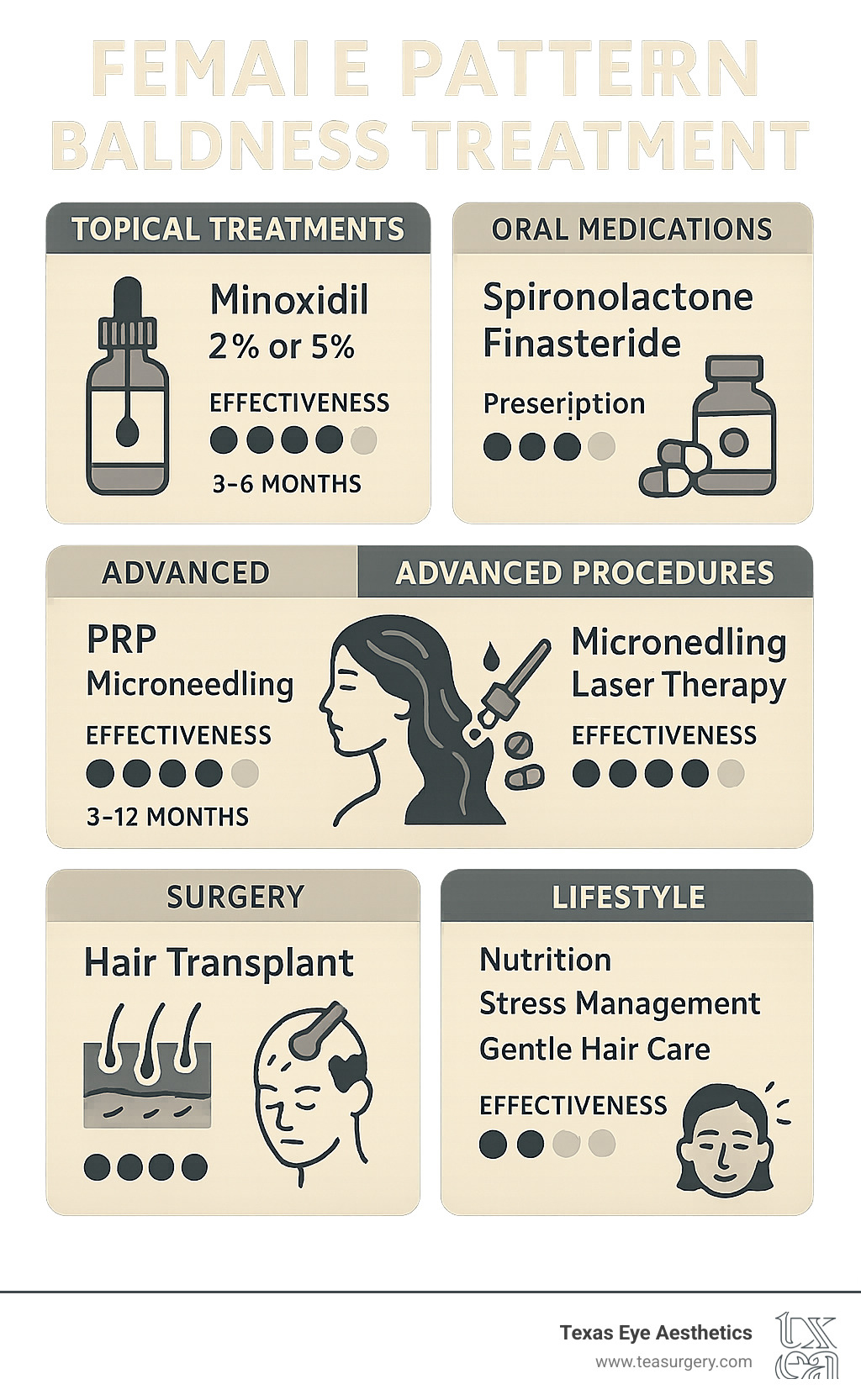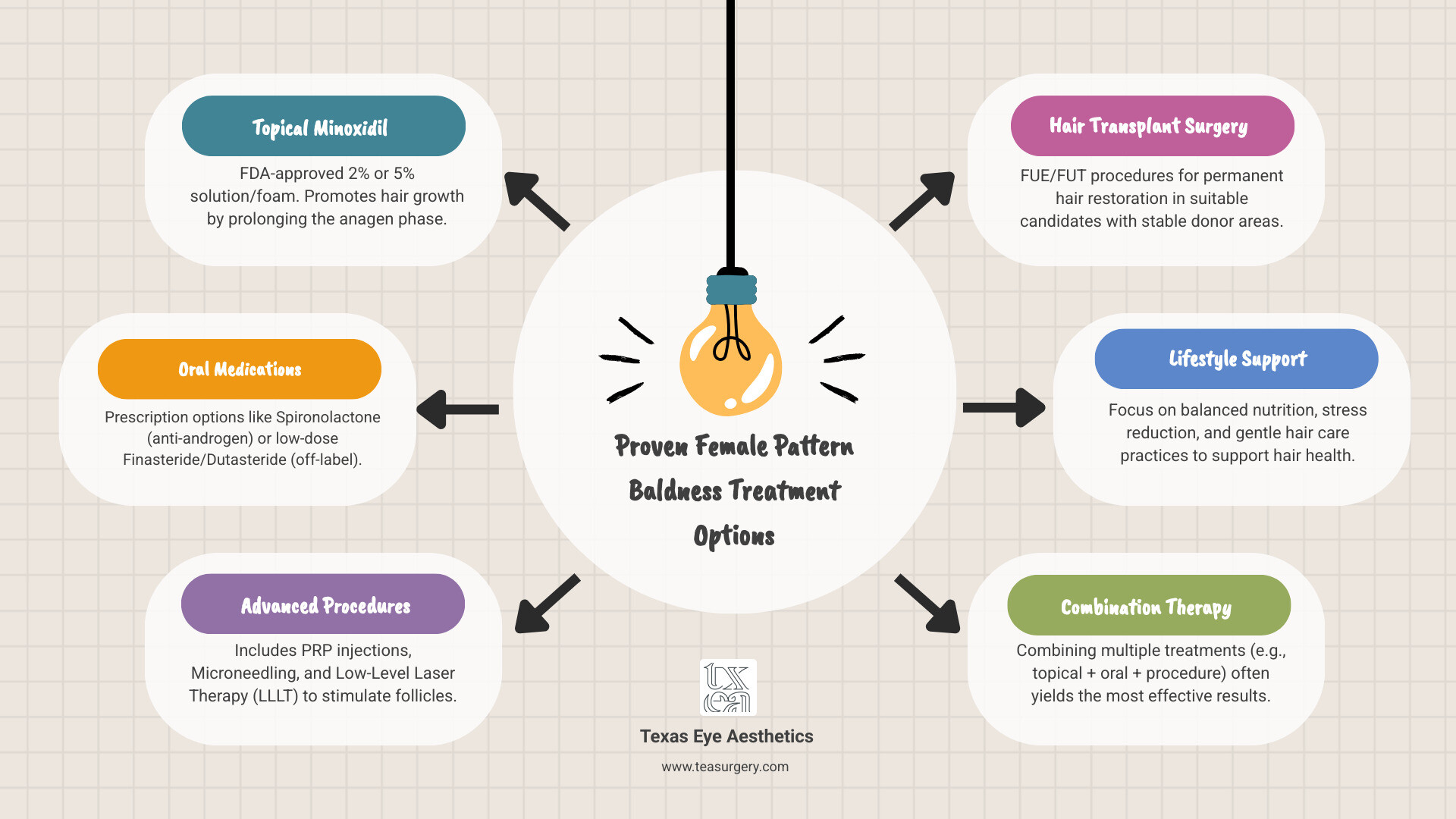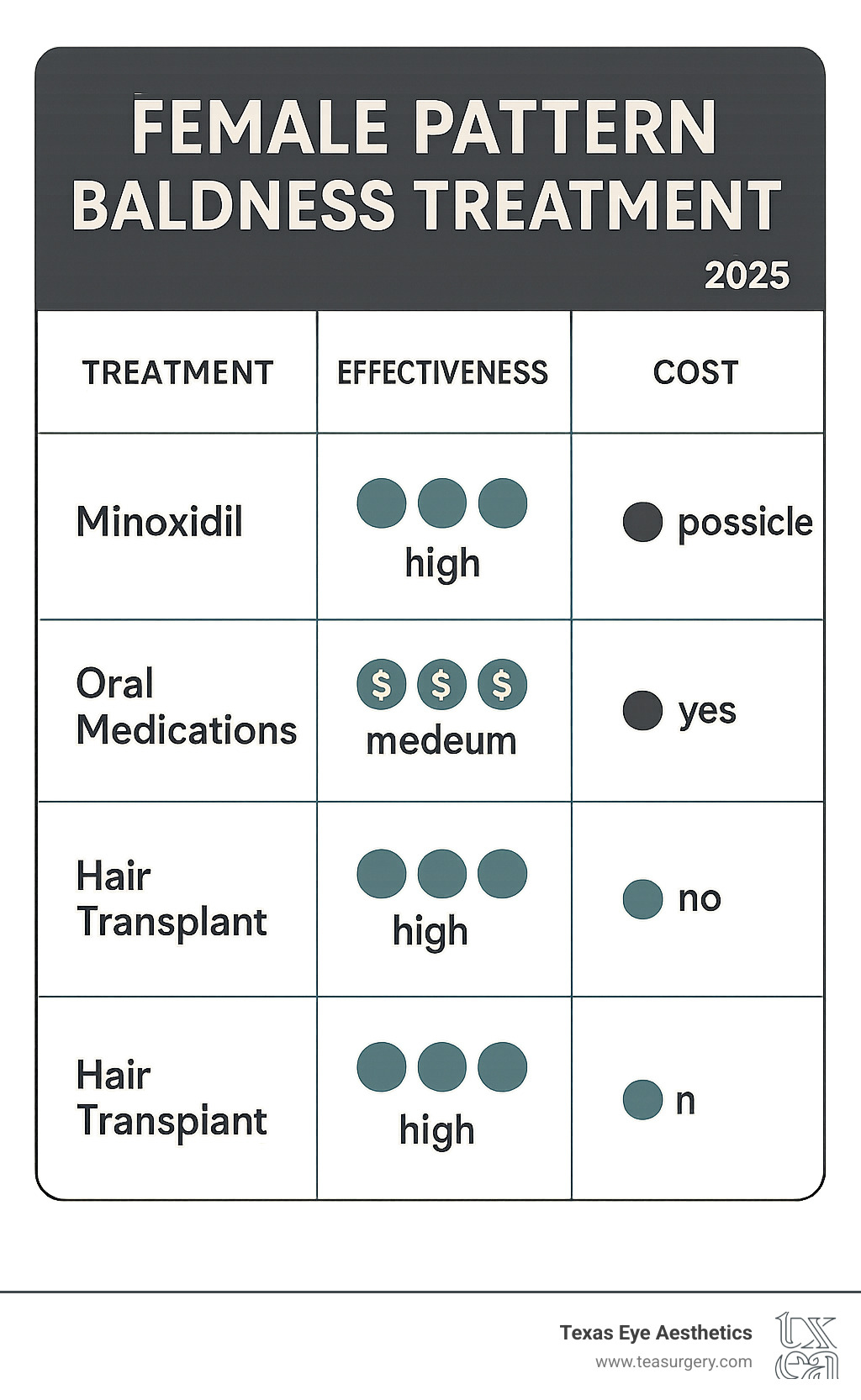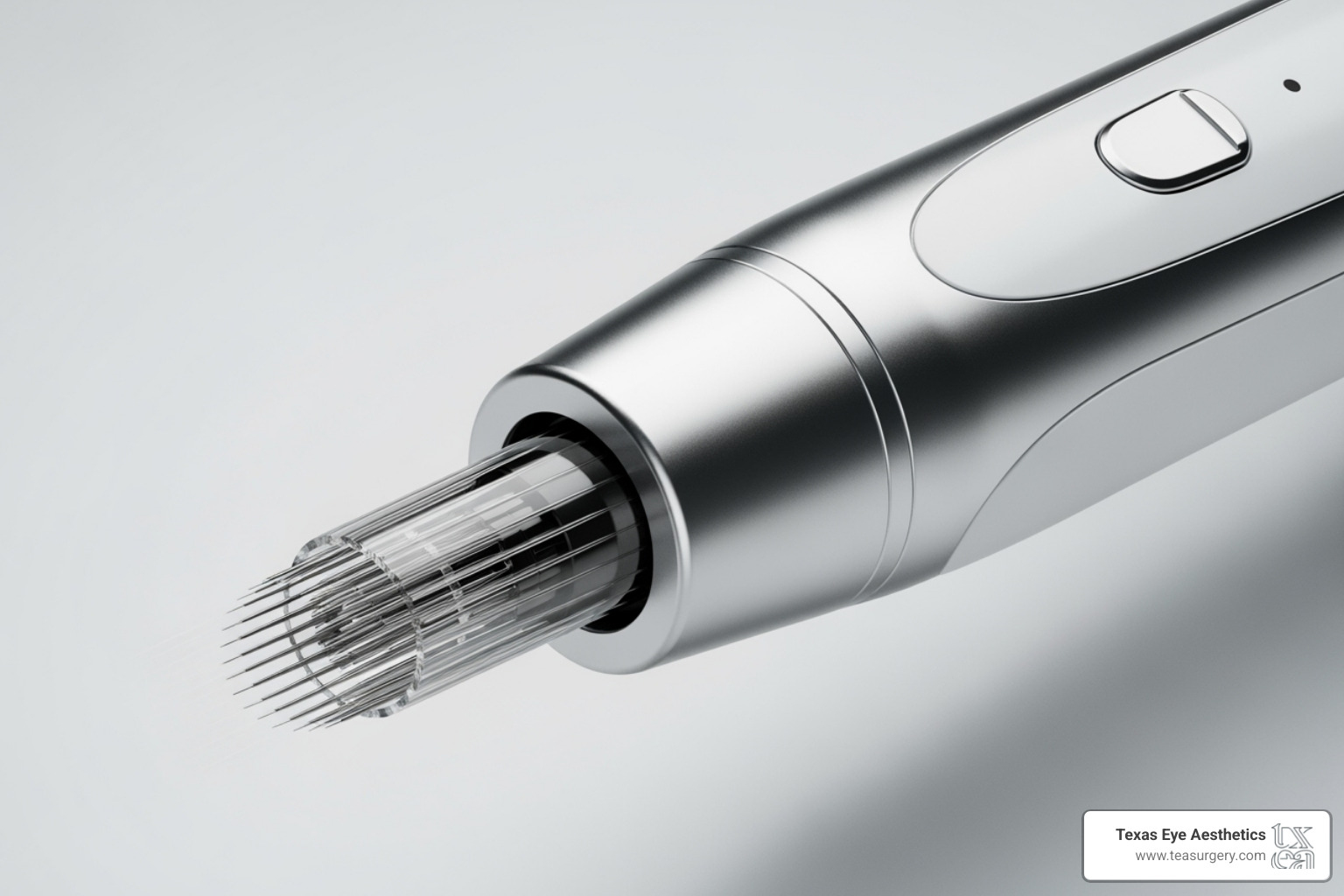Advanced female pattern baldness treatment options offer real hope for thicker, fuller hair. If you're experiencing hair thinning, you're not alone. Approximately 30 million women in the United States have female pattern baldness, and up to 75% experience some form of it by age 65.
Quick Answer - Proven Treatment Options:
Female pattern hair loss differs from male pattern baldness. Women typically experience diffuse thinning across the crown and top of the scalp—a widening center part often called a "Christmas tree pattern"—while maintaining their frontal hairline.
The good news is that hair follicles remain alive in female pattern baldness, meaning there's potential for regrowth with the right treatment. Early intervention is key to maintaining and potentially regrowing hair.
Research shows that combining treatments, such as topical minoxidil with procedural options like PRP, often yields the best results.


If your hair part is widening or your ponytail feels thinner, you might have female pattern baldness. This condition, androgenetic alopecia, affects millions of women in Central Texas and beyond. The good news is that you're not alone, and effective treatments are available.
Female pattern baldness looks different from male hair loss. Instead of a receding hairline, women typically experience gradual thinning across the top and crown of the scalp. Your hairline usually stays put, but your center part may widen into a "Christmas tree pattern."
This hair loss develops slowly and is permanent without treatment, unlike temporary shedding (telogen effluvium). Encouragingly, your hair follicles remain alive; they shrink but don't disappear, meaning female pattern baldness treatment can help restore growth.
The hair life cycle is key to understanding this condition. With female pattern baldness, the growth phase shortens while the resting phase lengthens, meaning hair spends less time growing. If you notice persistent thinning or a widening part, it's time for a professional evaluation. Early intervention offers the best chance of success.

Understanding the triggers for female pattern baldness—genetics, hormones, and aging—helps explain why certain treatments work.
Androgens (male hormones also present in women) are a key factor. Dihydrotestosterone (DHT), a potent androgen, causes sensitive hair follicles to shrink in a process called follicle miniaturization. Over time, these follicles produce finer, shorter hairs until they stop producing visible hair.
Your family history significantly influences your risk. If close relatives experienced hair thinning, you're more likely to develop the condition.
Hormonal changes can trigger or worsen hair loss. During menopause, declining estrogen levels can unmask the effects of androgens. About two-thirds of postmenopausal women experience some hair thinning.
Women with polycystic ovary syndrome (PCOS) often struggle with hair loss due to elevated androgen levels.
Aging naturally affects hair growth. As we get older, follicles spend less time in the active growth phase, leading to overall thinning.
The scientific research on factors in female pattern hair loss continues to reveal new insights about these complex interactions.
Recognizing symptoms early makes a significant difference. The most common sign is gradual thinning on the top and crown of the scalp, with a widening part and a preserved frontal hairline.
This diffuse hair loss pattern differs from male pattern baldness. Instead of distinct bald spots, women experience an overall reduction in hair volume.
During your consultation, diagnostic tests help confirm the cause. A hair pull test assesses shedding, while blood tests can rule out underlying conditions like thyroid disorders or iron deficiency.
A scalp biopsy can provide a definitive diagnosis by revealing follicular miniaturization under a microscope.
Differentiating from telogen effluvium is crucial. Telogen effluvium causes rapid, widespread shedding triggered by stress or illness, while female pattern baldness develops gradually. This distinction helps us recommend the right female pattern baldness treatment.

Several proven treatment options can make a real difference for female pattern baldness. The key is finding the right combination for your situation and starting early to improve your chances of maintaining and regrowing hair.
A multi-faceted approach often yields the best results, combining medical treatments with advanced procedures custom to your needs. Because hair follicles remain alive, we have multiple pathways to stimulate regrowth. Success requires consistency and patience, as most treatments take at least three to six months to show noticeable results and require long-term maintenance.

Topical minoxidil is the first line of defense and the only FDA-approved over-the-counter medication for female pattern baldness. It's available as a 2% solution (applied twice daily) or a 5% foam (used once daily). The 5% foam is often preferred for its convenience and may be more effective, helping about 1 in 4 to 5 women regrow hair.
Minoxidil works by widening blood vessels in the scalp, increasing blood flow to hair follicles. This extends the hair's growth phase and can enlarge miniaturized follicles, leading to thicker hair. Application is straightforward: apply to a dry scalp and massage it in. Initial shedding can occur but is often a sign the treatment is working.
Side effects are generally mild and may include scalp irritation or unwanted facial hair growth, especially with the 5% solution. Consistent, long-term use is required to maintain results. You can learn more in this Research on minoxidil effectiveness.
If topical treatments aren't sufficient, or if hormones are a key factor, oral medications can be an effective part of your female pattern baldness treatment plan. These require a prescription and medical supervision.

Advanced therapies can boost your female pattern baldness treatment results, often in combination with medical treatments.

While medical treatments are the foundation of female pattern baldness treatment, a holistic approach is vital. Daily habits, nutrition, and emotional well-being all play important roles in supporting your hair health.
While we can't entirely prevent genetic hair loss, we can create the best possible environment for your hair to thrive. Think of lifestyle support as the foundation that helps your medical treatments work more effectively.
Your diet directly impacts hair growth. Addressing nutritional gaps can significantly improve hair health as part of your female pattern baldness treatment. Key nutrients include:
Discuss any dietary changes with your doctor.
The Mediterranean diet, rich in vegetables, lean proteins, healthy fats, and whole grains, provides the essential building blocks for healthy hair.
Hair-healthy foods to include:
You can explore more in this research on The role of vitamins and minerals in hair loss.
Hair loss can be emotionally devastating for women, often shaking one's sense of identity and confidence. Acknowledging this emotional toll is the first step toward healing.
We know dealing with hair loss brings up many questions. Here are answers to the most common concerns about female pattern baldness treatment.
Patience is key, as hair growth takes time. Timelines vary by treatment:
An initial shedding phase in the first few weeks of some treatments, like minoxidil, is often a good sign that weaker hairs are making way for stronger ones.
Female pattern baldness isn't technically "curable," as it requires ongoing treatment to maintain results. However, because the hair follicles remain alive, the right female pattern baldness treatment can often halt progression and stimulate regrowth from miniaturized follicles.
The key is early intervention. It's much easier to reactivate a follicle that has only recently become dormant. While we manage the condition rather than cure it, many women achieve excellent results that improve hair density and confidence.
Unfortunately, most insurance plans consider female pattern baldness treatment to be cosmetic and do not cover costs for treatments like minoxidil, oral medications, PRP, or surgery.
However, if your hair loss is caused by a diagnosed underlying medical condition (e.g., thyroid disease, iron deficiency), the tests and treatments for that specific condition may be covered. Prescription medication consultations might also be covered, even if the drugs are not.
You may be able to use HSA/FSA funds if a doctor prescribes a treatment for a diagnosed medical condition with a letter of medical necessity. Always check directly with your insurance provider and HSA/FSA administrator before starting treatment.
Taking action against hair loss can feel overwhelming, but you are not alone. The most effective female pattern baldness treatment is personalized and started early.
Getting the right diagnosis is crucial. Self-diagnosis can be misleading, as many conditions cause hair thinning. A specialist can perform the proper tests to determine the exact cause of your hair loss and recommend the correct approach.
Your treatment plan will be as individual as you are, considering your age, pattern of hair loss, health, and lifestyle. It may involve a single therapy or a combination of approaches.
Managing expectations is key. Female pattern baldness treatment requires patience and consistency. Noticeable results typically take three to six months, with the best outcomes appearing after a year of consistent use. The goal is to slow progression and improve density, which often requires ongoing maintenance to preserve your results.
For residents of Central Texas, including Dripping Springs TX, Kyle TX, and Temple TX, the team at Texas Eye Aesthetics provides expert consultations. Dr. David Z. Gay and his team understand the impact of hair loss on your confidence and are committed to helping you explore your options with compassion.
Seeking help for hair loss is an act of self-care. Take the first step toward healthier hair and renewed confidence today.
More info about our aesthetic services